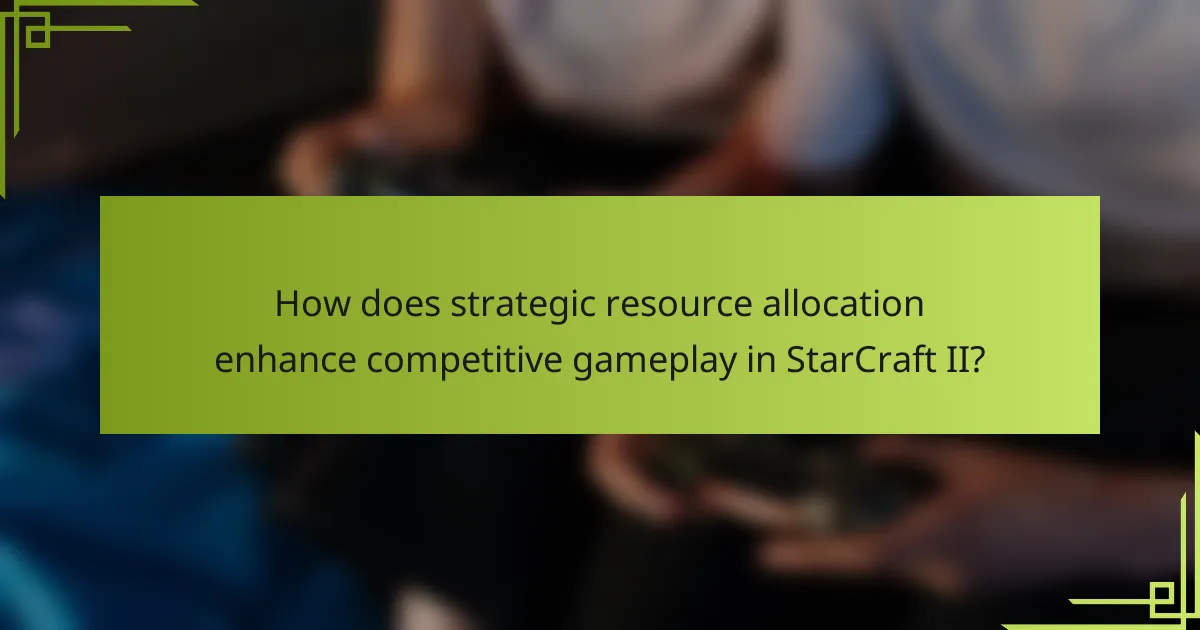Effective resource allocation in StarCraft II enhances competitive gameplay and community engagement. Players can optimize unit production and technology upgrades while adapting strategies in real-time. Community collaboration fosters resource sharing and mentorship, improving overall gameplay experiences. Understanding faction-specific challenges and innovative strategies further enhances resource management and player success.

How does strategic resource allocation enhance competitive gameplay in StarCraft II?
Strategic resource allocation significantly enhances competitive gameplay in StarCraft II by optimizing unit production and technology upgrades. Effective management of resources allows players to build stronger armies and adapt strategies in real-time. By prioritizing essential upgrades and troop compositions, players can counter opponents’ tactics and maintain an advantage. This dynamic decision-making process is crucial for success in high-stakes matches.
What are the key resources in StarCraft II and their strategic importance?
The key resources in StarCraft II are minerals, gas, and supply, each crucial for unit production and strategy. Minerals are the primary currency for building structures and units. Gas enables advanced technology and units, making it vital for late-game strategies. Supply limits the number of units a player can control, impacting overall strategy and army size. Effective resource management is essential for gaining a competitive edge in gameplay.
Which strategies maximize resource efficiency in different game modes?
Resource efficiency in StarCraft II is maximized through strategic planning and adaptation to game modes. Key strategies include focused resource gathering, effective unit composition, and adapting to opponent strategies.
1. **Focused Resource Gathering**: Prioritize harvesting minerals and gas based on unit requirements. For example, early game favors minerals for rapid expansion, while tech-heavy strategies require gas.
2. **Effective Unit Composition**: Balance your army with units that complement each other. For instance, combining melee units with ranged support enhances combat effectiveness.
3. **Adaptation to Opponent Strategies**: Scout frequently to adjust your strategy. If facing a heavy air composition, prioritize anti-air units to maintain resource efficiency.
4. **Map Control and Expansion**: Secure additional bases to increase resource intake. Controlling key locations can provide strategic advantages and sustain longer engagements.
How do player skill levels impact resource allocation decisions?
Player skill levels significantly influence resource allocation decisions in StarCraft II. Higher skill players efficiently manage resources, optimizing their strategies for maximum impact. They prioritize unit production and upgrades based on opponent behavior, adapting quickly to changing game dynamics. In contrast, lower skill players may struggle with resource management, often leading to suboptimal unit deployment and strategy execution. This disparity in skill levels creates a distinct approach to resource allocation, affecting overall game performance and community engagement.

What role does community engagement play in resource sharing among players?
Community engagement fosters collaboration and trust among players, enhancing resource sharing. Players who actively participate in community discussions are more likely to exchange strategies, tips, and in-game resources. This collaborative environment leads to improved gameplay experiences and a stronger sense of belonging within the StarCraft II community. Engaging with others also creates opportunities for mentorship, where experienced players can guide newcomers, facilitating knowledge transfer and resource sharing. Overall, community engagement is vital for strategic resource allocation, ensuring that players can maximize their potential and enjoyment of the game.
How do in-game alliances influence resource distribution?
In-game alliances in StarCraft II significantly enhance resource distribution by enabling coordinated strategies among players. Alliances allow players to share resources, leading to optimized economic growth and strategic advantages. This collaboration can shift the balance of power, as allies can pool their resources for larger armies or technological advancements. Additionally, alliances can influence player interactions, leading to more dynamic gameplay and resource management strategies, ultimately enriching the community experience.
Which community platforms facilitate strategic discussions on resource management?
Community platforms that facilitate strategic discussions on resource management in StarCraft II include Discord, Reddit, and TeamLiquid. These platforms provide spaces for players to share strategies, discuss resource allocation, and collaborate on improving gameplay. Discord offers real-time communication and dedicated channels for specific topics. Reddit hosts diverse threads where players can ask questions and share insights. TeamLiquid features forums tailored to StarCraft II, with detailed discussions on resource management tactics.

What unique challenges do players face in resource allocation across different factions?
Players face unique challenges in resource allocation across factions due to differing strengths and weaknesses. Each faction in StarCraft II requires distinct strategies for optimal resource management. For instance, Terran players often need to balance between unit production and technological upgrades, while Zerg players must prioritize rapid expansion and unit spamming. Protoss players face the challenge of high-cost units that demand careful resource allocation. Additionally, players must adapt their strategies based on the opposing faction’s resource management tactics, creating a dynamic gameplay experience. Understanding these nuances is essential for enhancing community engagement and competitive play.
How do faction-specific attributes affect resource management strategies?
Faction-specific attributes significantly influence resource management strategies by dictating how players allocate and utilize resources. Each faction in StarCraft II possesses unique characteristics that shape their economic approaches. For instance, Terran units often require more minerals early on, while Zerg can rapidly produce units with fewer resources. This distinction necessitates tailored strategies for effective resource allocation.
Additionally, the timing and type of resource gathering differ among factions. Protoss players may prioritize gas for advanced technologies, while Zerg players focus on expanding their bases quickly to maximize mineral income. As a result, understanding these faction-specific attributes allows players to develop more efficient resource management strategies, ultimately enhancing their gameplay experience.
What are the common pitfalls in resource allocation for each faction?
Common pitfalls in resource allocation for each faction include mismanagement of supply, neglecting unit composition, underestimating expansion timing, and failing to adapt strategies. These mistakes can lead to inefficient use of resources and ultimately impact game performance. For Terran, prioritizing upgrades over unit production can weaken defenses. Zerg often struggle with overcommitting to early aggression, neglecting economy. Protoss may face pitfalls in balancing tech progression and army size, leading to vulnerability. Understanding these faction-specific challenges enhances strategic resource allocation.

Which rare strategies can lead to unexpected advantages in resource allocation?
Innovative strategies that leverage unconventional unit compositions and unexpected timings can yield significant advantages in StarCraft II resource allocation. For instance, utilizing a mix of low-cost units to distract opponents while accumulating resources can shift the game’s momentum. Additionally, surprising tech switches can catch opponents off guard, allowing for more efficient resource use. Adapting to the opponent’s strategy in real-time creates opportunities for unexpected advantages in resource management.
How can unconventional resource management lead to victory?
Unconventional resource management can lead to victory in StarCraft II by fostering innovative strategies. Players who allocate resources creatively can outmaneuver opponents. For instance, prioritizing unconventional unit compositions can surprise adversaries, creating tactical advantages. Effective resource allocation enhances the community by encouraging diverse playstyles and strategies, enriching the overall gaming experience.
What are some historical examples of successful rare strategies in competitive play?
Historical examples of successful rare strategies in competitive StarCraft II include the use of unconventional unit compositions and unexpected timings. One notable instance is the “Mothership Core” strategy employed by Protoss players to control map vision and defend against early aggression. This unique approach allowed players to secure economic advantages while maintaining defensive capabilities.
Another example is the “Baneling Bust” strategy used by Zerg players. By focusing on a rare combination of Banelings and Roaches, players could surprise opponents and break through fortified defenses. This strategy showcased the effectiveness of unconventional tactics in high-stakes matches.
Terran players have also utilized rare strategies, such as the “Battlecruiser Rush.” This tactic involves an early investment in Battlecruisers to apply pressure and disrupt opponents’ economies. The rarity of this strategy made it particularly effective against unprepared opponents.
These examples highlight how rare strategies can shift the dynamics of competitive play, emphasizing the importance of innovation and adaptability in StarCraft II.

How can players optimize their resource allocation for long-term success?
Players can optimize resource allocation in StarCraft II by focusing on strategic planning and efficient management. Prioritize gathering resources early to establish a strong economy. Balance production and expansion to maintain a steady flow of units. Utilize scouting to adapt strategies based on opponent movements. Implementing these tactics fosters long-term success in gameplay.
What best practices should players follow for effective resource management?
Players should prioritize effective resource management by balancing income, expenditure, and strategic planning. Focus on these best practices:
1. **Prioritize Economy**: Establish a strong economic foundation early by expanding resource collection.
2. **Plan Unit Production**: Allocate resources efficiently for unit production based on opponent strategies.
3. **Upgrade Timely**: Invest in upgrades to enhance unit effectiveness during critical game phases.
4. **Scout Regularly**: Gather intelligence to adapt resource allocation based on enemy movements and strategies.
5. **Avoid Overcommitting**: Maintain flexibility by not over-investing in any single unit type or strategy.
Which common mistakes should players avoid in resource allocation?
Players should avoid common mistakes like overcommitting resources, neglecting upgrades, mismanaging unit production, and failing to scout opponents. Overcommitting can lead to vulnerabilities, while neglecting upgrades diminishes combat effectiveness. Mismanaging unit production can create imbalances, and insufficient scouting prevents informed decision-making. Balancing these aspects enhances strategic resource allocation in StarCraft II.
How can players leverage community insights to enhance their strategies?
Players can leverage community insights to improve their strategies by actively engaging in discussions and analyzing shared experiences. By participating in forums and watching replays, players gain diverse perspectives on tactics and resource management. Community-driven content, such as guides and tutorials, offers valuable information on optimal build orders and unit compositions. Additionally, collaborating with others fosters a deeper understanding of game mechanics and meta shifts, enhancing overall gameplay. Embracing these insights allows players to adapt strategies effectively and stay competitive in StarCraft II.